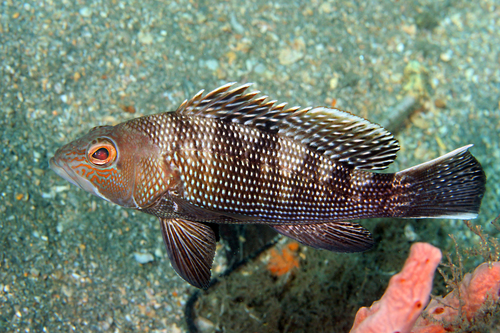
Black Sea Bass
The Atlantic Bluefin Tuna (Thunnus thynnus) is a highly migratory, large pelagic fish renowned for its size, speed, and commercial value. This species plays a crucial role in the marine ecosystem and is a top predator. They are known for their incredible migrations across the Atlantic.
3 20 years
Lifespan
66 cm
Length
Near Threatened
Conservation Status
15 km/h
Swimming speed
Carnivorous, Scavengers
Diet
Seasonal Migration
Migration
Appearance Overview
The Atlantic Bluefin Tuna is renowned for its large, streamlined body, built for speed and endurance.
Color
Dark metallic blue on top with a silvery underside
Body shape
Torpedo-shaped
Fins
Two dorsal fins, the first is yellow or blue, the second is reddish-brown
Length
Up to 13 feet (4 meters)
Weight
Up to 2,000 lbs (907 kg)
Diet
Carnivorous, feeding on a variety of fish, squid, eels, and crustaceans.
Feeding Behavior
Highly active predators, they use their speed and agility to hunt, often in coordinated schools to corral prey.
Social Behavior
Forms large schools, especially during migration, which can include thousands of individuals.
Commercial Relevance
Extremely high value, especially in sushi and sashimi markets, making it one of the most expensive fish in the world.
Conservation measures
Subject to international fishing quotas, stock management plans, and monitoring efforts, including tagging programs.
Status
Endangered
Threats
Overfishing, driven by high demand in the sushi market, and bycatch in other fisheries.
Habitat Distribution
Depth Range
0-1,000 meters (0-3,280 feet), though more commonly found in shallower waters.
Geographic Range
North Atlantic Ocean, including the Mediterranean Sea; ranges from Newfoundland to the Gulf of Mexico in the west, and from Norway to North Africa in the east.
Preferred Environment
Primarily pelagic, inhabiting both coastal and open ocean waters, preferring temperate to subtropical regions.
Reproduction and Life Cycle
Breeding Habits
Spawns in two main areas: the Mediterranean Sea and the Gulf of Mexico. Spawning occurs in warm waters during spring and summer.
Development Stages
Eggs hatch into larvae that drift with the currents. Juveniles grow rapidly, feeding on plankton and small fish. They gradually develop into top predators.
Fecundity
Highly fecund; females can produce up to 30 million eggs per spawning season.
Maturity Age
Reaches sexual maturity relatively late, around 4-8 years, depending on the population.
Faqs about Black Sea Bass
Can I eat Bluefin Tuna?
Yes, but it's crucial to ensure it's from a sustainably managed source due to overfishing concerns.
How long do Bluefin Tuna live?
Up to 40 years in the wild.
Where can I find Atlantic Bluefin Tuna?
Atlantic Bluefin Tuna are found in the Atlantic Ocean, from Newfoundland to the Gulf of Mexico, and from Norway to the Mediterranean Sea.
How fast can Bluefin Tuna swim?
They can reach speeds up to 43 mph (70 km/h).
What is a unique characteristic of the Bluefin Tuna?
Bluefin tuna are warm-blooded, which is unusual among fish, allowing them to maintain a higher body temperature than the surrounding water.
How much does Bluefin Tuna cost?
The price can vary widely, but prime cuts can fetch tens of thousands of dollars at auction.
What do Bluefin Tuna eat?
They primarily feed on smaller fish like herring, mackerel, and squid.
How many eggs do Bluefin Tuna lay?
Females can release millions of eggs during spawning.
What is the biggest threat to Bluefin Tuna?
The biggest threat is overfishing, due to high market demand.
Do Bluefin Tuna migrate?
They migrate thousands of miles across oceans, often returning to the same spawning grounds.
Copyright @ Nature Style Limited. All Rights Reserved.
 English
English